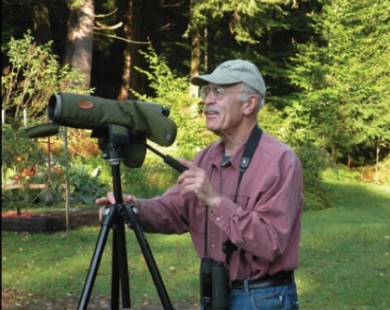
From his urban roots in New Jersey to his life in rural Vermont, citizen scientist Ed Hack has maintained a love of nature and a steadfast commitment to participation in a wide array of citizen science projects. © Sandy Hack
Despite my urban roots in Paterson, New Jersey, a second generation son of working class immigrants, I never considered myself a city person. I played ball and ran the streets with friends but always had an eye turned to the woodlot. At family picnics, I’d often be found turning over rocks and hunting creek bottoms for hidden critters. I’ve never stopped the search. Although my love of nature never translated directly into a profession, I consider myself a “career” citizen scientist.
I attended public schools, where my leanings towards math and science guided me to a premed major at Rutgers University. I quickly realized, however, that being a doctor was not in the cards, so I completed a degree in Biological Sciences. Not until I began working on my masters at the University of Delaware did the light finally switch on. I found myself staring out the windows at a world that beckoned to me. Environmental Science, a field gaining in prominence, was where I belonged. But the academic world had run its course for me, and I didn’t want to start over. I finished my masters and sought a position in the working world, one that might satisfy my need to be close to nature.
I set my sights on Vermont, moving here with my wife Sandy in 1970. A wildlife biologist job at the Vermont Fish & Wildlife Department failed to materialize when the program was discontinued, just before I was due to start. However, I was here to stay, so looked elsewhere and found work in the construction world. I enjoyed working with my hands and treasured a job that allowed me to be mostly out-of-doors. I soon started my own masonry business, which continues to this day.
Soon after arriving in Vermont, I met Fred Merrill, an accomplished Woodstock birder and a knowledgeable amateur botanist. Fred introduced me to the importance of songs and calls in bird identification, and he served as a great mentor. I also became aware of a fledgling environmental organization, VINS, whose office was then located in a small Woodstock village store. I quickly became acquainted with VINS’ co-founder Sally Laughlin and volunteer Julie Nicholson. Both were instrumental in launching my involvement as a “citizen scientist.”
It wasn’t long before I found myself sitting down with Sally to determine an appropriate circle for the Woodstock Christmas Bird Count. No Google Earth in those days—we made do with a nail and a length of string to plot our 15-mile radius. Julie, Sally and I did the count together every year, with only a few misses, until Julie’s passing in 2009. Sally and I are still at it.
During the mid-1970s, Julie and Sally recruited me for the first Vermont Breeding Bird Atlas. If I wasn’t much of a birder at the start, I felt like a veteran five years later! It was a tremendous learning experience, and I enjoyed it immensely. Twenty-five years later we did it all over again, and it was just as much fun.
Whenever masonry threatened to interfere with my volunteering in the field, Julie provided a welcome prod. Her quiet enthusiasm and can-do attitude made it difficult to say no. More often than not, my response to Julie’s requests for help on a VINS or VCE project would be, “What time should I be there?”
Over the years, I’ve counted spring migrants for the Silvio Conte NWR “Migratory Bird Stopover Habitat Survey”, slogged up peaks at dawn for Mountain Birdwatch, and stalked under the hot sun with a net to learn my fritillaries and skippers for the Vermont Butterfly Survey. Most recently, the Vermont County Birding Quest and eBird have captured my attention. The combination of fun, discovery, and camaraderie leave me wishing I had time to do more. I also wish Julie was still here to do it all with me.
—Ed Hack
